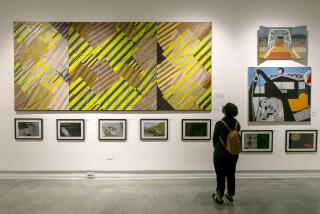Critic’s Notebook: Andy Warhol — the ghost in MOCA
When a respected group of dissident trustees complained in a recent letter to The Times about the new direction being taken by the Museum of Contemporary Art, at the top of its list of concerns was “the caliber of its exhibitions.”
MOCA Director Jeffrey Deitch vigorously disagreed in a subsequent interview, but the group’s vexation is understandable. A certain homogenized sameness pervades the new program, which is about as boring as having the same Campbell’s soup every day for lunch.
Yes, MOCA is becoming the Andy Warhol Museum. Although one of those already exists in Pittsburgh, the ghost of the late, great Pop artist, dead now for a quarter-century, hovers in the background — and sometimes steps into the foreground — of almost every exhibition conceived by Deitch in the last 18 months.
“I was just fascinated by the counterculture that Andy created through his art, his films, his Factory,” Deitch told The Times when he arrived at MOCA two years ago, after a lengthy tenure as an art investment adviser and gallery owner in Manhattan. “I can almost say that I moved to New York to meet Andy Warhol.”
Now that he’s moved to L.A., scene of Warhol’s first major gallery show in 1962, he’s brought the artist’s vintage ethos with him. Here’s a list of 10 MOCA exhibitions he added since the fall of 2010, followed by my unofficial subtitle for each:
“Dennis Hopper Double Standard” (Andy Warhol put Dennis Hopper in a 1964 underground movie).
“Naked Hollywood: Weegee in Los Angeles” (Andy Warhol loved celebrity tabloids).
“Kenneth Anger: Icons” (Andy Warhol made great camp movies).
“Andy Warhol Campbell’s Soup Cans” (Andy Warhol first showed them in L.A.).
“Art in the Streets” (Andy Warhol loved ‘80s graffiti art by Keith Haring andJean-Michel Basquiat).
“Hedi Slimane: California Song” (Andy Warhol launched the ‘70s red-carpet fanzine Interview).
“The Total Look: The Creative Collaboration Between Rudi Gernreich, Peggy Moffit and William Claxton” (Andy Warhol was a ‘60s fashion maven).
“James Franco’s ‘Rebel’” (Andy Warhol made outsiders into superstars).
“The Painting Factory: Abstraction After Warhol” (Andy Warhol mass-produced abstract paintings).
“Fire in the Disco” (forthcoming, but I refer to this one as “Andy Warhol loved the old Chez Régine and Studio 54”).
The shows so far have varied in size and ambition. Atypically for a museum, curatorial duties have either been handled by the director or outsourced to freelancers. (“Fire in the Disco” will be too.) Six have been reviewed in The Times — two favorably, three negatively, one mixed.
The dull monotony, though, explains much of the dissatisfaction with the program. Its narrow focus is repetitious and terribly dated. Nostalgic Warholism isn’t all there is in art today.
MOCA representatives have said the new program reflects “a paradigm shift” happening now in art and museums, but that’s just marketing talk. Skip cable TV’s “Mad Men.” Instead read Thomas Kuhn’s 1962 book “The Structure of Scientific Revolutions” and you’ll understand why. That’s where the popular concept of paradigm shift was born.
Kuhn wrote that fundamental scientific change requires irreversible laboratory proof, a set of facts that establish a new archetype. Basic assumptions about art, on the other hand, are always contested and in flux. That, he noted, is one thing that makes it art.
Art museums prove nothing. Their core curatorial job remains essentially unchanged — to chronicle and contemplate the wide and ever-changing stew. That’s what New York’s Metropolitan Museum of Art, not exactly an avatar of the new or the now, will undertake this fall with its big exhibition “Regarding Warhol: Sixty Artists, Fifty Years.”
The show, organized by a guest curator plus a senior staff curator, has been a few years in the making. The plan is to bring together paintings, sculptures and films by Warhol, who died 25 years ago, with diverse works by scores of other artists that reinterpret or respond to his achievement. Think of it as an incisive conversation among artists about art.
The Met — America’s most popular art museum, by the way — hasn’t done a contemporary thematic show since 2009. How it turns out remains to be seen, but the subject is rich and provocative.
Ironically, it’s also just the kind of fresh examination of recent art history that MOCA is known for. Or used to be, before it went out to lunch.
christopher.knight@latimes.com
More to Read
The biggest entertainment stories
Get our big stories about Hollywood, film, television, music, arts, culture and more right in your inbox as soon as they publish.
You may occasionally receive promotional content from the Los Angeles Times.







